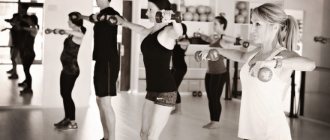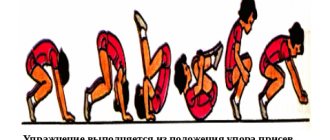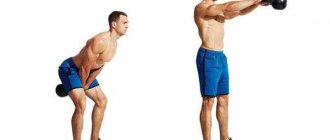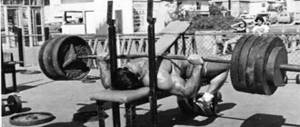In 1953, at some university in England, Morgan and Anderson came up with circuit training.
Circuit training for physical education lessons at a university or school is very convenient because it perfectly organizes the work of the group. But everyone understands that working in a group is difficult to combine with the individual characteristics of the body.
The essence of circuit training is very simple. A group of 20 unorganized people is divided into two subgroups of 10 people. This is done so that while some are training, others are sitting on a bench in an orderly manner and watching.
It is easier for a physical education teacher or coach to monitor ten ignoramuses than twenty.
The second issue is the issue of equipment. In 1953 there was not much equipment. But a dozen sports equipment could be found.
So, a horizontal bar, a parallel bars, a kettlebell, a jump rope - the equipment was distributed to 10 students. Then the command was given: “start the exercise.” We practiced for half a minute, there was a whistle and the command: “swap equipment.”
So in about 10 minutes, 10 people somehow trained their bodies. Then there was a change in composition. The first ten go to the bench to watch as the second one exchanges sports equipment at the whistle.
In a word, circuit training is a very convenient way to keep 20 people busy so that no one interferes with each other or quarrels because someone does not have enough sports equipment for training.
There were skeptics who questioned the wisdom of public circuit training for selfish personal reasons.
Then Cooper conducted research and said that oxygen consumption and maximum heart rate in housewives and businessmen still increase from circuit training.
“Go crazy!” - thought housewives and businessmen. If we don’t lose weight, then at least increase our maximum oxygen consumption.
Since then, circuit training has gained popularity among people because there is nothing more enjoyable than sitting in front of a computer and watching fitness models doing circuit training.
My favorite thing to watch is former porn actress Zyuska Light's circuit training.
What do you like to watch on the screen of your computer or smartphone when you have nothing else to do? Write comments - share your joy 
Features of this type of training
Circuit training is considered a high-intensity type of training that requires certain preparation. The heart muscle is significantly involved, receiving a large load when performing a series of exercises sequentially.
This type of training, in its essence, is closer to aerobic exercise, since during classes a number of movements are performed without interruption, and accordingly, the heart rate is at the same level. However, various exercises can be performed, including strength ones.
Training in this style has a number of features:
- exercises are performed sequentially, without a pause between them;
- may consist of both strength and aerobic movements;
- after the end of the circle, the exercises are repeated, a short pause between circles is allowed;
- exercises are performed in a multi-repetition mode;
- No more than 1-2 exercises are performed for each muscle group.
Important! Circuit classes can be organized both at home and in the gym. Depending on the goal and level of training of the athlete, the exercises he performs will be selected. For example, when losing weight, it is better to devote time to movements with your own weight and energy-consuming multi-joint movements, and when working on relief, perform strength ones.
In bodybuilding, strength training is used either for cutting and cutting weight, or to add variety to the training process. With the second option, classes should not last too long; from a week to three will be enough. Heavy multi-joint exercises are selected, and at first, exercises on simulators.
Why do you need training?
Circuit training in the gym involves doing different exercises quickly and alternating them. This allows the body not only to quickly return to tone, but also to stimulate the active growth of muscle mass. In exercises, the number of repetitions should not change, and by increasing the load, lactic acid is produced for muscle growth.
In the process, the duration of the workout will change, but the level of load will increase, due to which the body will begin to actively develop and form the necessary muscle groups. You cannot immediately take on a large load, so as not to injure the soft tissues; you need to do this gradually.
Due to rapid fat burning, the level of growth hormone increases. In men, this process occurs faster than in women, which is due to the characteristics of the body. If you combine circuit training in the gym with active intake of sports vitamins and a complex of amino acids, the result will manifest itself much faster.
What loads are suitable?
The set of exercises when using the circuit training method can be very diverse. Both aerobic and anaerobic movements are used, among the most basic are the following:
- squats. Different types of squats with different implements can be used;
- lunges, both with a barbell and dumbbells;
- jumping on a bench or other types of jumps;
- running, jumping rope and other types of cardio. In circuit classes, the cardio lasts only briefly, for example, for five minutes, then the athlete moves on to the next movement;
- classic weightlifting movements, such as the clean and jerk, clean and jerk, and so on;
- exercises on simulators for different muscle groups;
- working with dumbbells on biceps, triceps, shoulders and other parts of the body;
- crunches, leg lifts and other abdominal movements;
- bodyweight exercises such as push-ups, pull-ups, etc.
- exercises with a kettlebell, for example, snatch, arm raise, and so on.
When drawing up a training plan, you need to follow some rules:
- two consecutive exercises for circuit training should not train the same muscle of the body;
- each movement is performed for about half a minute. The weight must be selected so that the movement requires effort, but at the same time can be performed the required number of times in a row;
- Before starting a workout, a thorough warm-up is required to minimize the risk of injury.
Almost any exercise is suitable for circuit training. The main thing is that the athlete knows how to perform them correctly and follows the basic principles when drawing up a training plan.
Who is circuit training for?
Circuit training is not suitable for every athlete. No, it's not about genetics. Just on an ongoing basis, it is not very effective. But if you are one of the people listed below, then it will definitely help you. Who are we talking about?
Beginners. For beginners, this is the most effective training program that exists. I'm talking about people who came to the hall for the first time. Their body is not yet prepared for training with the separation of muscle groups. Also, the brain cannot use the necessary neural connections to engage certain muscles in work. And of course, the technique of execution for beginners will be lame. And so it will be difficult for them to understand how to do more complex isolation exercises.
After a long break from training. This applies to all athletes of any level of training who, for some reason, had a break from training. Even 5 days of sickness or vacation is enough. In general, the reason is not important. During this time, your muscles will have time to waste a certain share of their working potential. I don’t want to go into the chemical reactions that will occur in the body during this time. But believe me, he will have time to weaken. Therefore, if you immediately give it a heavy load, you will suddenly drive yourself into overtraining. And here you can forget about proper recovery.
If you have enough time for 1-2 workouts per week. Here it is worth immediately clarifying some points. If you go to the gym 2 times a week, and at this time you are at the stage of gaining weight. Then you can safely work according to the usual program with the separation of muscle groups. In all other cases, if there is a lack of time, a circuit program will give you the opportunity to develop the whole body. In this case, the training will take only 30-40 minutes.
Professionals and beginners during cutting (lose extra pounds). Many professional athletes use circuit training during periods of preparation for competitions. Thanks to them, they burn excess fat and achieve their peak shape. The same goes for beginners who want to lose extra pounds. Many trainers recommend circuit training; due to its intensity, it allows you to burn fat without losing muscle mass.
Of course, if you just like circuit training, then go ahead. I don't force anyone. But still, before choosing exercises and starting to act. You need to understand what principles to use to build this program.
Ready-made program for all muscle groups for men
The circuit training program will depend on a number of factors, such as the athlete's level of training, his goals, capabilities, and so on. In any case, it should include at least five exercises, which are performed one after another.
Attention! It is recommended to split your workouts over several days, for example three days a week. This way, the muscles will have more opportunities to recover. Beginners can do the same exercises aimed at strengthening ligaments, developing heart muscle, and endurance. Dividing into days makes sense in later stages.
For beginners
Circuit training for a beginner who has not previously trained at all can consist of a series of simple movements, for example:
- push-ups, 20 times;
- squats, 20 times;
- pull-ups, 10 times;
- parallel bars push-ups, 15 times;
- hanging leg raises, 15 times.
This is the simplest option, which is used at a very early stage. Next, after about a month of such classes, you can divide the program into days and perform more complex movements:
| Workout 1 |
|
| Workout 2 |
|
| Workout 3 |
|
All exercises are performed for 15-20 repetitions. You should not choose the maximum working weight; you need to take into account that there are still several exercises ahead in the program, which the athlete must have the strength to perform.
Hypertrophy training
This is a type of training program for gaining muscle mass quickly. The point is to increase the volume and number of repetitions, which is what the emphasis is on in execution.
It is not recommended to use the program for a long time, since it puts a lot of stress on the central nervous system and can cause fatigue.
In the process, there will be an increase in strength, but not as significant as with less loads. Correct technique plays a huge role here, and you need to keep an eye on it. Beginner athletes should avoid a hypertrophy training program.
Main conclusions
Circuit training is a broad concept. The exercises used in this training method can range from bodyweight movements to heavy multi-joint movements with a barbell, dumbbells or kettlebells.
It is fundamentally important for an athlete to correctly combine such exercises into a complex. Their sequence should be such that each previous exercise does not interfere with the correct execution of the next one, and by each subsequent workout the muscles are at least partially restored.
What are the benefits of circuit training?
Save time
By taking a short rest, you can do more in less time. For example, if your workout consists of 5 strength exercises of 3 sets each, you will spend about 43 minutes on it and 28 of them will be resting between sets. By reducing your rest to 30 seconds in circuit training, you will complete all the exercises in 22 minutes.
Pumps the respiratory tract and heart
With little or no rest, circuit training will simultaneously improve Acute Effects of Three Different Circuit Weight Training Protocols on Blood Lactate, Heart Rate, and Rating of Perceived Exertion in Recreationally Active Women muscle strength, and VO2max Whole-Body Aerobic Resistance Training Circuit Improves Aerobic Fitness and Muscle Strength in Sedentary Young Females - maximum oxygen consumption, a reliable indicator of aerobic power.
Helps you lose weight
A high heart rate throughout the workout helps Effects of high-intensity circuit training, low-intensity circuit training and endurance training on blood pressure and lipoproteins in middle-aged overweight men quickly reduce fat and increase muscle mass.
How to do circuit training at home?
Circuit training is a set of 4-8 exercises for the whole body, which are repeated in several circles. You can independently choose for yourself a list of exercises, the duration of their implementation and the number of circles. Circuit training is fast paced
, the exercises are performed one after another without a break (or it is very short), there is a stop only directly between circles. You can train either with your own body weight or using additional equipment.
Circular training at home for girls usually involves exercises for all muscle groups
upper and lower body. Even if you only need to correct, for example, your hips, do not forget about exercises for your arms and abdomen. More varied exercises and loading as many muscles as possible will help you burn more calories, which means your workout will be more effective. If you have a particular problem area, you can add exercises to the circle that focus on that area.
So, the basic rules
performing circuit training to burn fat:
- Circuit training includes 4-8 strength and cardio exercises for the entire body.
- The exercises are performed in one approach one after another without a break (or with a minimum break of 10-20 seconds).
- Exercises are performed on a count or for a time at your discretion (at least 10 repetitions or at least 20 seconds in time).
- Between circles you are supposed to rest for 1-3 minutes.
- Determine the number of laps yourself, but most often circuit training lasts about 30 minutes.
If you want to lose weight, then do circuit training at home 3-5 times a week
30 minutes each (excluding warm-up and cool-down). Since you are working out at home without a trainer, adjust your load yourself. Don't overdo it, but don't forget that without progress there will be no result. Gradually increase the training time, increase the weight of the dumbbells, reduce the rest time between circles, and speed up the speed of the exercises.
Benefits of circuit training for weight loss:
Thanks to circuit training, you will burn fat and lose weight. Exercises for all muscle groups will make your body toned and elastic without problem areas.
Circuit training strengthens muscles and increases cardiac and muscular endurance. This is an excellent cardiovascular workout.
You can always independently adjust the duration and intensity of the circuit training. These programs are easy to follow, very flexible and convenient.
This is a great time saver, since circuit training at home has a high energy consumption. They help speed up metabolism and launch additional fat burning processes in the body.
You will need minimal additional equipment for classes.
Contraindications for circuit training:
- Weak physical fitness (newcomers to sports)
- Cardiovascular diseases
- Recent surgery or injury
- Problems with the musculoskeletal system or joints
- Pregnancy and postpartum period (minimum 2 months)
If you have any medical conditions that are incompatible with vigorous activity, consult your doctor before performing circuit training at home.










